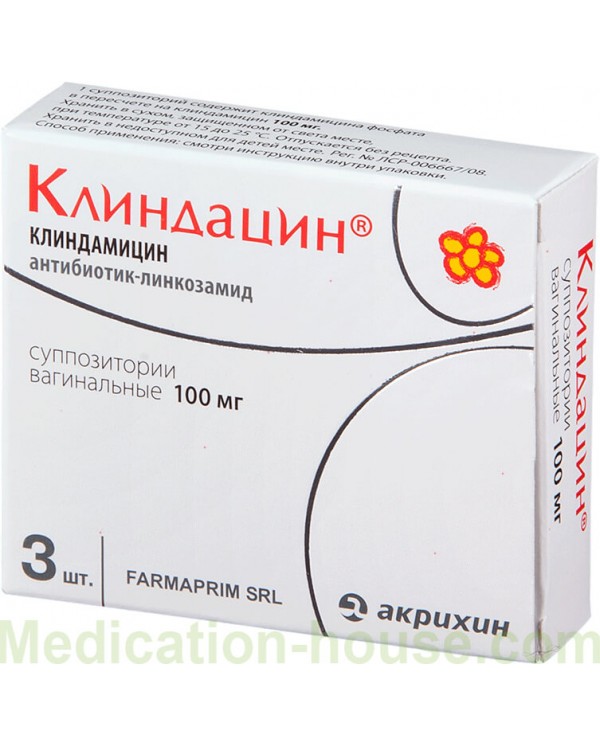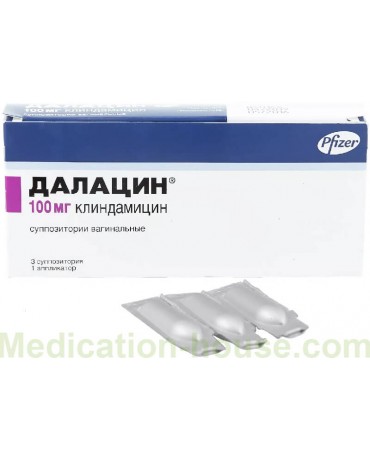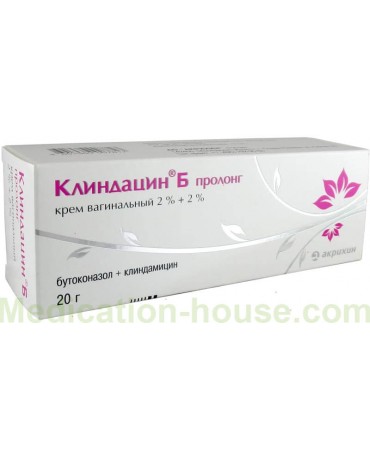Clindacin user manual
You can buy Clindacin on this page
Clindacin is an antibiotic belonging to the group of lincosamides and is active against a wide range of pathogenic microorganisms. The release form of this drug predetermines its use especially by the fair sex.
Release form
Clindacin is available in two dosage forms: vaginal cream and vaginal suppositories (they are also suppositories).
The cream is a white substance with a slight yellowish tinge of the corresponding consistency, placed in aluminum tubes of 20 or 40 g. In addition to the tube with the medicine itself, special applicators (respectively 3 or 7, depending on the amount of cream in the tube) for installation are also put into the secondary packaging cream in the vagina. The concentration of the active substance (clindamycin acts in its role) is 2%, i.e. 2 mg in 1 g. This dosage form is produced by the oldest Russian pharmaceutical company "Akrikhin".
Vaginal suppositories have a color similar to cream, are packaged at the rate of 3 candles in one individual package. The content of clindamycin is 100 mg per suppository. The manufacturer of Clindacin in the form of vaginal suppositories is Pharmaprim LLC (Moldova), and the candles are packed with the same domestic Akrihin.
Pharmachologic effect
Clindamycin has a bacteriostatic (does not destroy, but inhibits development) effect, although a bactericidal effect is also possible in high concentrations. Penetrating into the bacterial cell, the antibiotic inhibits protein synthesis, which prevents the microorganism from growing and developing properly. The spectrum of action of the drug extends over a wide range. Clindacin is active against certain types of staphylococci and streptococci. It is effective for bacterial vaginosis caused by gardnerella, mobiluncus, bacteroids, mycoplasma, and some types of clostridia. According to the reviews of practitioners about Clindacin, the drug does not act on Trichomonas and Candida, and has cross-resistance with lincomycin.
Indications for use
The instructions for Clindacin are laconic: the drug is used for vaginal dysbiosis (alternative names are bacterial vaginosis or vaginal dysbiosis) caused by pathogens that are sensitive to the drug. For reference: vaginal dysbiosis develops when the vaginal lactoflora is replaced by aggressive associations of microbes.
According to reviews of Clindacin, if bacteria of the genus Clostridia are the causative agent of the infection, then it is necessary to conduct a bacteriological study of the patient's bioassay (sowing a smear on a nutrient medium) to determine the sensitivity of the seeded microflora to antibiotics.
Instructions for use
The cream is inserted into the vagina using the aforementioned disposable applicator enclosed in the medicine package. This manipulation is detailed and illustrated in the instructions for Clindacin. It does not pose any difficulty: the applicator is screwed onto the neck of the tube, filled with cream (you need to press on the tube itself, and not pull the piston of the applicator), and is inserted into the vagina as shown in the picture in the instructions. The applicator will also help in dosing the drug. A single dose of Clindacin in the form of a cream is 100 mg, that is, one fully filled applicator. It is most convenient to install the medicinal cream in the vagina before going to bed. The duration of treatment is three to seven days.
Before insertion into the vagina, the candle is removed from the contour packaging, which must be cut with scissors along the contour of the cell with the candle. The introduction should be as deep as possible, which is easiest to do while lying down. The frequency of administration and the duration of treatment are the same as in the case of the cream.
Contraindications
There are few negative reviews about Clindacin. There is (very rarely) individual intolerance to clindamycin (it is more likely in the presence of it and in relation to lincomycin). Clindacin is not recommended for the first three months of pregnancy. In the future, given the fact that clindamycin tends to penetrate the placenta into the fetal bloodstream, taking Clindacin is justified only if the possible benefit of taking the drug outweighs the potential risk. This is also true for breastfeeding women. There were no reviews of Clindacin in relation to its use in children, its efficacy and safety for them has not been confirmed.
Side effect
Reviews of Clindacin speak of its good tolerance. In some cases, the following are possible:
allergic manifestations in the form of itching, urticaria, rash;
on the part of the urogenital tract - cervicitis (an inflammatory process localized in the cervix), colpitis (inflammation of the vaginal mucosa), irritation of the external genital organs;
very rarely - abnormal blood counts (neutropenia, agranulocytosis, eosinophilia, thrombocytopenia).
The systemic effect of the drug (as, in fact, and analogues of Clindacin) is weak, in some cases, symptoms of pseudomembranous enterocolitis (frequent bowel movements, abdominal pain, heart palpitations) may develop, which sometimes happens while taking certain antibiotics.
There were no reviews of Clindacin associated with his overdose.
Special instructions
If Clindacin is used systematically, then it is possible to create favorable conditions for the growth of candida, which, as noted above, are insensitive to this drug.
If dyspeptic disorders (including diarrhea) occur, you should temporarily refrain from using Clindacin.
It is better not to combine the drug with other intravaginal agents and use it solo, which applies to both suppositories and cream.
According to the instructions for Clindacin, the cream is dispensed with a prescription, candles - without it.
Storage term and conditions
The temperature regime for storing the cream and suppositories is somewhat different: for the first, it is up to 20 ˚С, for the second, the optimal condition is the temperature range from 15 to 25 ˚С. The storage place, of course, should be as far as possible inaccessible to children. The shelf life is 3 years, after which the drug is not recommended to be used.
Terms of sell
You can buy Clindacin without a prescription.



